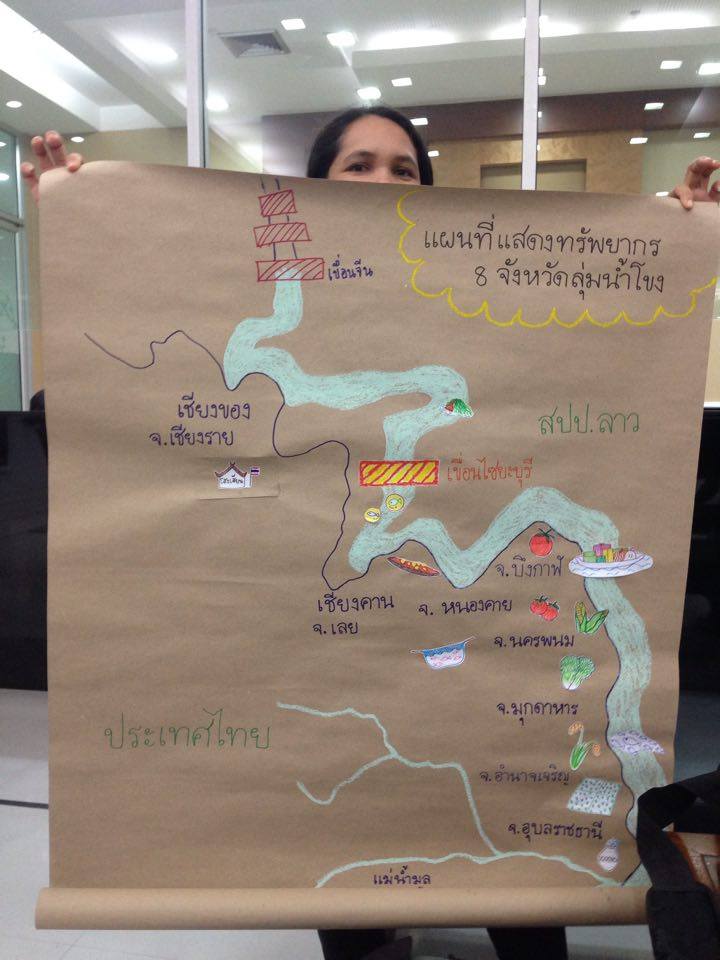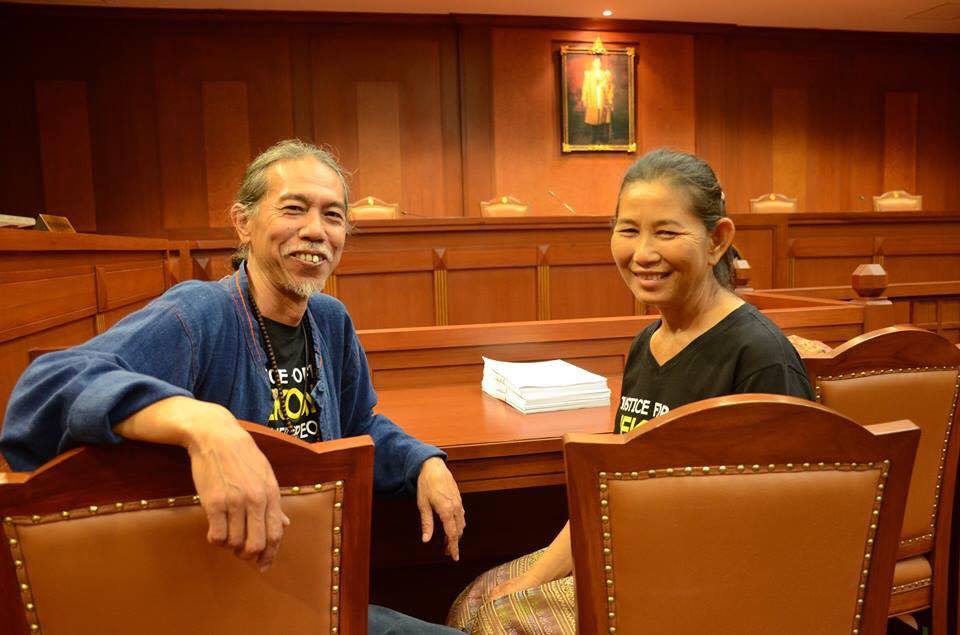In June 2014, 37 Thai villagers filed a case against the signing of the Power Purchase Agreement for the controversial Xayaburi Dam. This week, the court heard directly from the community members in their own words. It was the first time this had happened since the case was accepted.
During an hour-and-a-half hearing at the Administrative Court in Bangkok, the court heard testimony from two of the plaintiffs. The judges listened carefully to the plaintiffs and took notes during their testimony.

The case has attracted significant attention within the Mekong region, as it continues to highlight ongoing concerns about the Xayaburi Dam and whether communities can voice these concerns and demand that their rights are recognized and protected.
Direct Testimony
The majority of the 37 plaintiffs were present at the court, having traveled from North and Northeast Thailand to attend the hearing. They entered the courtroom holding photographs of their homes along the Mekong River, as well as images of their riverbank gardens and fish traps — visual reminders of what’s at stake from the transboundary impacts of the Xayaburi Dam upstream in Laos.
Niwat Roykaew, a community leader from Chiang Khong addressed the court first.
“For the past two decades, we have experienced drastic impacts after a series of dams were built upstream in China, some hundreds of kilometers away from our home in Chiang Rai, Northern Thailand. To date, the Xayaburi Dam construction is already halfway completed. The Mekong River at the construction site is now flowing through a concrete structure that reaches across half of the Mekong River’s width. The construction seems to be proceeding very quickly and it is likely to generate electricity for Thailand, for purchase through EGAT, as planned,” Roykaew said.Map of the Mekong shows the critical resources that support the lives of communities along the river.
“However, social and environmental transboundary impacts as a result of the dam still have not been made public. No one can tell us how many fish species will be blocked from migrating upstream to spawn. All the designs for fish passage and fish lifts are still just an experiment. No one can tell us how many riverine communities, fishers, gardeners, gold panners and ordinary villagers will be affected.
“Xayaburi Dam is the first dam on the Lower Mekong, and this lawsuit is going to be a standard for future projects on the Mekong and in the region. The value of this legal case is it could create a path to extraterritorial obligations for Thailand’s investment overseas. And make us, as a country, more responsible.”
Mrs. Sorn Champadok, a mother, fisherwoman and villager from Phosai District in Ubon Ratchatanee, spoke as well. “My home is in Phosai District in Ubon Ratchatanee. I am a mother of five children; we are a fishing family. We also grow plants on the Mekong’s banks during the dry season. We have made our entire living from the Mekong River. Lots of fish we catch and also use to make fermented fish, and sell to buy rice, so that we have fish and rice.
“Fishing in the Mekong has meant that we have enough money to send our kids to school. In fishing months like October, we have sold our fish and earned as much as 50,000 THB for a month. But for the past years we have seen adverse changes to the river ecosystems and water levels. Fish catch has declined. Our income and sources for foods are affected. This has happened after the dams were built on the Upper Mekong in Yunnan, China.Niwat Roykaew and Mrs. Sorn Champadok inside the courtroomby Montree Chantawong
“I am concerned that the Xayaburi Dam construction will make even more negative impacts on the Mekong River, resources and our lives.”
The Significance of the Case
In an Opinion piece published in The Bangkok Post on Monday, Sor Rattanamanee Polkla, one of the lawyers representing the plaintiff villagers, highlighted the importance of the case: “It is the first community-filed public interest lawsuit in the region concerning destructive dam-building on the Mekong River,” she said. “It represents a critical legal mechanism to protect community rights. It also highlights the Xayaburi dam’s transboundary impact and corresponding obligations to ensure the rights of those affected, regardless of where the project is located.”
In accepting the case in June 2014, the Supreme Administrative Court did so in recognition that the Xayaburi Dam poses a transboundary threat to the Mekong River and to communities in Thailand.
The final verdict for the case has yet to be delivered, but we hope that in their decision, the court will prioritize the rights of Thai villagers over the interests of the companies involved in the Xayaburi Dam project, and that they will hold those responsible accountable for decision-making which will impact the lives of Thai citizens.
We urgently need laws in Thailand to address transboundary issues, and a legal system which works to uphold the rights of its people.More information:
Background to the case
- In 2011, The Electricity Generating Authority of Thailand (EGAT) signed the Power Purchase Agreement for 95% of electricity generated by the Xayaburi Dam, which was based on approval by four other Thai government agencies.
- 37 plaintiffs composing of villagers living in eight provinces along the Mekong in Thailand from Chiang Rai to Ubon filed a lawsuit against five government bodies, including the National Energy Policy Council, the Thai Cabinet, and the Electricity Generating Authority of Thailand (EGAT).
- The lawsuit claims that approval of the project’s Power Purchase Agreement (PPA) is illegal under both the Thai Constitution and the 1995 Mekong Agreement. The PPA made between EGAT and the Xayaburi Power Company Limited, was approved without an assessment of the project’s transboundary environmental and health impacts and without consultations in Thailand, in volition of the Thai Constitution. The case was accepted by the Supreme Administrative Court in June 2014.
- In accepting the case, the Court stated that communities in Thailand “are entitled to participate in the management, maintenance, preservation and exploitation of the natural resources and the environment, in a balanced and sustainable manner, in order to enable themselves to live a normal life consistently in an environment that is not harmful to their health, sanitation, welfare and quality of life.”
Timeline
- October 2011 – The Electricity Generating Authority of Thailand signs a Power Purchase Agreement with the Xayaburi Power Company Ltd to purchase 95% of the electricity from the Xayaburi Dam in Laos.
- August 7, 2012 – 37 villagers from communities along the Mekong River in North and Northeastern Thailand file a case with the Administrative Court in Thailand against five Thai Government agencies for their involement in the signing of the Power Purchase Agreement for the Xayaburi Dam.
- February 2013 – The Administrative Court deny jurisdiction to hear the case.
- March 2013 – The plaintiffs file a formal appeal with Thailand’s Supreme Administrative Court.
- June 24 2014 – Thailand’s Supreme Administrative Court accept the lawsuit.
- October 17, 2014 – Thai communities file an injunction with the Administrative Court calling for a halt to construction on the Xayaburi Dam while the Court rules on the case.
- July 24, 2015 – Final submission of evidence by the plaintiffs to the Court.
- November 30, 2015 – First case hearing.
Featured image: Niwat Roykaew and Mrs. Sorn Champadok inside the courtroom | Photo. by Montree Chantawong

